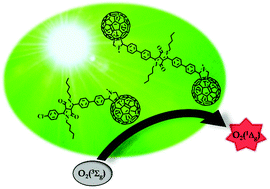Diketopyrrolopyrrole–fullerene C60 architectures as highly efficient heavy atom-free photosensitizers: synthesis, photophysical properties and photodynamic activity†
Abstract
Chromophore–fullerene C60 hybrids possess interesting properties that enable them to act as heavy atom-free photosensitizers and reactive oxygen species (ROS) producers. Here, two new diketopyrrolopyrrole–C60 conjugates were efficiently synthesized and characterized. The conjugates show broadband absorption in the visible spectral region, in which diketopyrrolopyrrole dyes act as light-harvesting antenna with very high capacity to populate excited triplet states. Furthermore, the ability of diketopyrrolopyrrole–C60 systems to generate singlet molecular oxygen was explored for the first time in solvents of different polarities. The experimental results show that these architectures exhibit very high production rates of this ROS. In addition, a preliminary study on Staphylococcus aureus cell suspensions indicates that both conjugates exhibit phototoxicity after irradiation with green LED light. Thus, the data obtained provide evidence that these diketopyrrolopyrrole–C60 architectures act as potential heavy atom-free photosensitizers in photodynamic inactivation of microorganisms and other singlet oxygen-mediated applications.

- This article is part of the themed collection: Celebrating Latin American Talent in Chemistry


 Please wait while we load your content...
Please wait while we load your content...